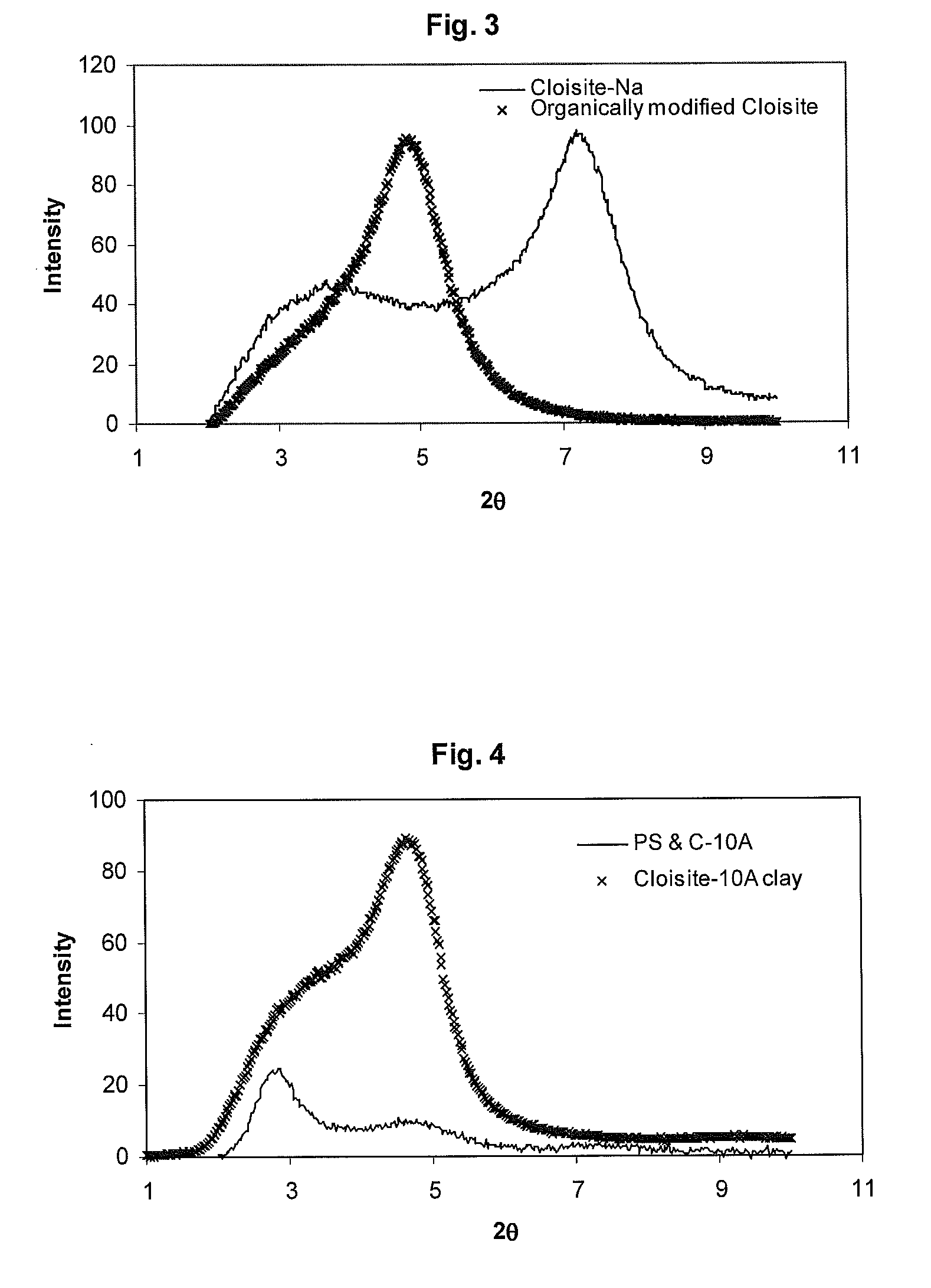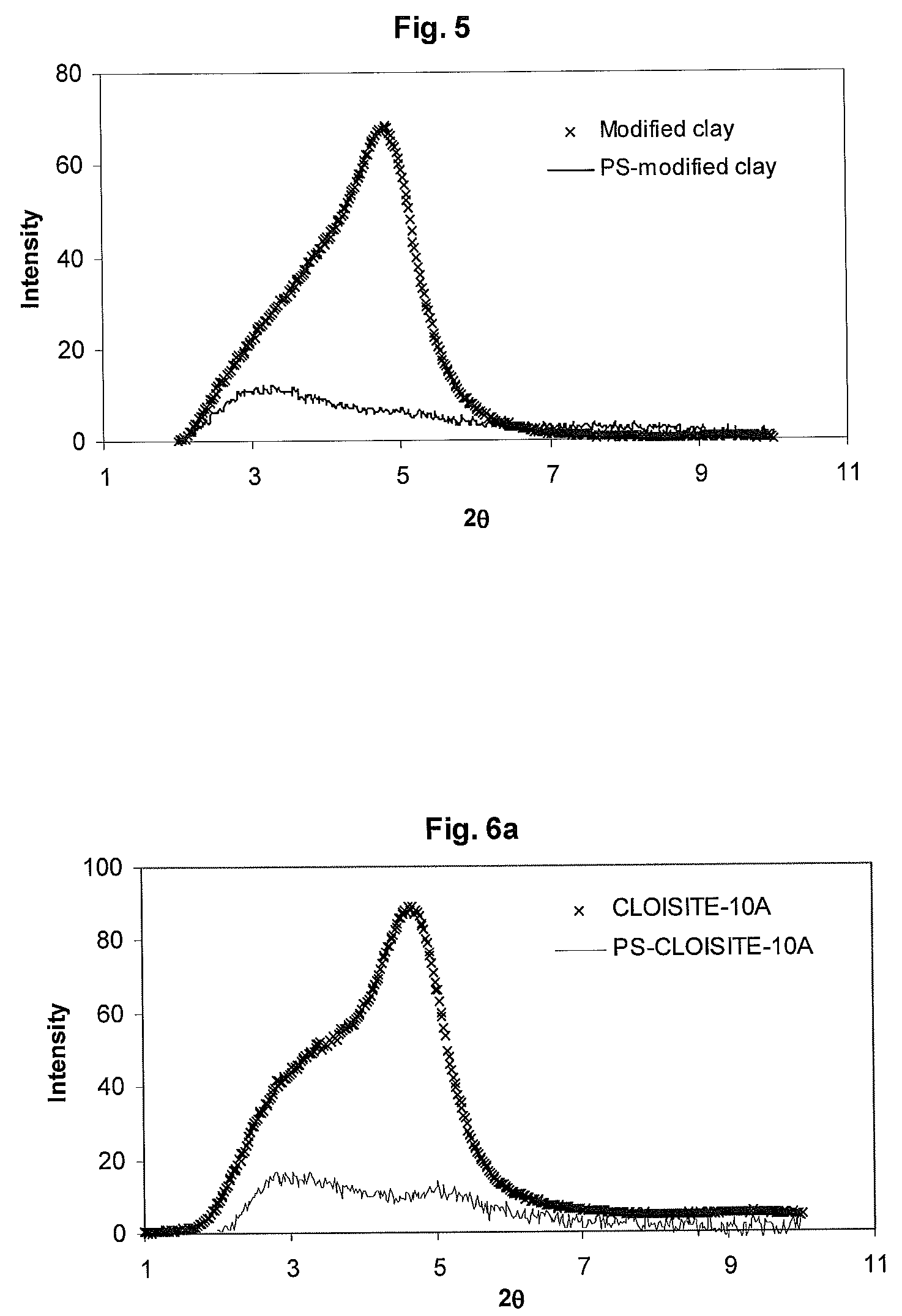Process for making polyolefin clay nanocomposites
- Summary
- Abstract
- Description
- Claims
- Application Information
AI Technical Summary
Benefits of technology
Problems solved by technology
Method used
Image
Examples
examples
[0166]X-ray diffraction (XRD) analysis was conducted on a Siemens General Area Detector Diffraction System using a Kristalloflex 760 X-ray generator with a power setting of 40 kV / 40 mA and a 0.5 mm collimator. Each nanocomposite blend was pressed into a 40 mm by 10 mm plaque measuring 1 mm in thickness using a Wabash-Genesis series compression molding press, according to ASTM D4703-03 density plaque conditions. All were run at a distance of 30.00 cm from the detector, where a total run collection consisted of 5×106 counts at a 0.154 nm wavelength (CuKα). FIGS. 5, 6a, 7a, 8a, 9a, 10a and 11a show the XRD patterns obtained after subtracting the polymer background from the polymer-clay nanocomposite samples.
[0167]The morphology of the nanocomposites was examined by use of a transmission electron microscopy (TEM). This investigation was performed on a Hitachi H7000 unit operated at an acceleration voltage of 75 kV. Samples were mounted on Epon blocks and ultramicrotomed using a diamond ...
examples 1 (
Examples 1(a)-1(h)
[0169]In general, CLOISITE®-Na+ (CLOISITE®-Na+ is an unmodified natural montmorillonite clay available from Southern Clay Products) was modified with a cationic surfactant and a free radical initiator comprising a positively charged functional group by simultaneous or sequential addition of the modifiers. The cationic surfactant and the cationic free radical were added at a temperature of between 0° C. and 5° C. to prevent the free radical initiator from comprising a positively charged functional group from decomposing or reacting. Small-scale clay modifications were based on 1.5 g of unmodified clay. A 500 ml glass beaker was used to hold 150 g of distilled water which was stirred with an overhead stirrer.
[0170](a) The unmodified clay, CLOISITE-Na+ was slowly poured into the mixing beaker of water. The mixture was stirred for 10 min to 24 hrs and placed in an ultrasonic bath for an additional ten minutes to 2 hours to ensure the clay particles were well dispersed....
example 2a
[0178]Modified clay which further contains sodium dodecylbenzene sulfonate (0.0987 g) as an anionic compound was made as above in Example 1(a), except that sodium dodecylbenzene sulfonate was added before the addition of the benzyldimethylhexadecyl-ammonium chloride and 2,2′-azobis(2-methylpropion-amidine)dihydrochloride. 2,2′-azobis(2-methylpropionamidine)dihydrochloride and benzyldimethylhexa-decylammonium chloride and were added simultaneously or sequentially. The sodium dodecylbenzene sulfonate was added to the clay dispersion as a solution in water. FIG. 3 shows an XRD pattern of clay modified with sodium dodecylbenzene sulfonate, benzyldimethylhexa-decylammonium chloride and 2,2′-azobis(2-methylpropion-amidine)dihydrochloride as well as an XRD pattern for commercially available CLOISITE-Na+.
PUM
| Property | Measurement | Unit |
|---|---|---|
| Temperature | aaaaa | aaaaa |
| Length | aaaaa | aaaaa |
| Fraction | aaaaa | aaaaa |
Abstract
Description
Claims
Application Information
 Login to View More
Login to View More - R&D
- Intellectual Property
- Life Sciences
- Materials
- Tech Scout
- Unparalleled Data Quality
- Higher Quality Content
- 60% Fewer Hallucinations
Browse by: Latest US Patents, China's latest patents, Technical Efficacy Thesaurus, Application Domain, Technology Topic, Popular Technical Reports.
© 2025 PatSnap. All rights reserved.Legal|Privacy policy|Modern Slavery Act Transparency Statement|Sitemap|About US| Contact US: help@patsnap.com



